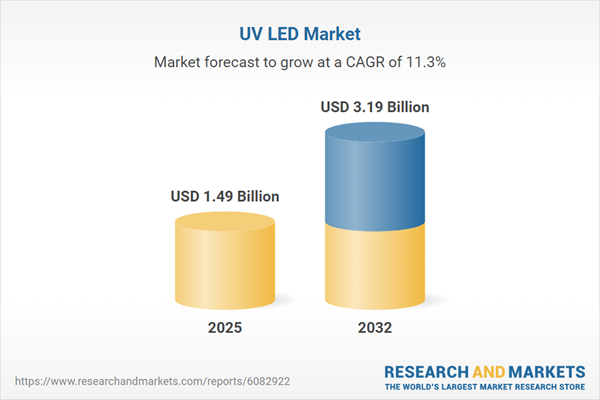Speak directly to the analyst to clarify any post sales queries you may have.
The ultraviolet LED market is rapidly evolving, offering senior decision-makers a critical vantage point for innovation-driven growth, sustainability, and operational resilience. As companies adapt to shifting global landscapes, this sector offers both strategic opportunities and complex challenges.
Market Snapshot: UV LED Market Size and Growth Trajectory
The global ultraviolet LED market rose from USD 1.35 billion in 2024 to USD 1.49 billion in 2025, with an expected CAGR of 11.34% leading to USD 3.19 billion by 2032. Industry expansion is being propelled by swift advancements in semiconductor technology, greater adoption within disinfection and medical sectors, and the push for tighter environmental regulations. Organizations are aligning with the heightened demand for efficient, long-lasting, and sustainable solutions. Moreover, regulatory evolution and supply chain shifts are shaping procurement, deployment, and partnership strategies for UV LED solutions worldwide.
Scope & Segmentation: Comprehensive View of UV LED Innovations
- Product Types: LED chips and LED modules meet requirements for both custom integrations and standardized systems in a multitude of market uses.
- Wavelengths: Options across UV-A, UV-B, and UV-C allow tailored applications such as air purification, phototherapy, and sterilization, giving organizations flexibility in deployment.
- Power Ratings: High-power units target industrial curing, medium-power options serve versatile needs, and low-power devices address portable or niche scenarios.
- Packaging Formats: Chip on board and surface mount device packages ensure streamlined assembly, enhanced heat management, and adaptable installation across sectors.
- Applications: Curing adhesives, coatings, and inks; conducting air and surface disinfection; enabling medical phototherapy and sterilization; supporting pest control; providing water disinfection; and addressing cosmetic industry needs.
- Distribution Channels: Online and offline platforms together extend industry reach, covering mass-market buyers and specialized sectors alike.
- End Users: Consumer electronics firms, healthcare organizations, industrial manufacturers, and research entities all play essential roles in advancing adoption.
- Regional Coverage: Coverage includes major economies and emerging markets in the Americas, Europe, Middle East and Africa, and Asia-Pacific regions. Each brings unique regulatory expectations and infrastructure readiness to UV LED adoption.
- Key Players: Influential industry participants span established corporations such as Nichia Corporation, ams-OSRAM AG, Broadcom Inc., and Seoul Viosys, as well as niche innovators and regional startups driving market momentum.
Key Takeaways for Senior Decision-Makers
- Latest advances in semiconductor materials and optical engineering are strengthening UV LED system performance, while supporting broader sustainability mandates.
- Shifting regulatory landscapes strongly favor mercury-free solutions, increasing the need for safety focus and environmental compliance in product planning.
- New application areas, especially in smart water, medical, and industrial processing, are highlighting the adaptability and strategic value of UV LED technology across multiple domains.
- Supply chain realignment and regional production gains are fortifying sector resilience, creating opportunities for both established international players and agile local suppliers.
- Organizations that integrate ultraviolet LEDs with predictive maintenance and monitoring can achieve greater reliability and respond quickly to shifting operational demands.
Tariff Impact: Navigating Shifting Trade and Supply Chain Strategies
Recent U.S. tariff changes have led companies to reassess sourcing and logistics, accelerating domestic manufacturing and the development of local partnerships. This shift is impacting cost structures, encouraging relocation of production, and strengthening regional supply networks. Increased investment in local R&D is empowering industry participants to navigate fluctuations more effectively and to safeguard business continuity across the ultraviolet LED sector.
Methodology & Data Sources
This market analysis is built on direct interviews with industry executives, engineers, and key end-users, backed by comprehensive secondary research from technical publications, regulatory documents, and patent reviews. Rigorous analytics and multi-source verification underpin strategic recommendations tailored for senior leaders.
Why This Report Matters
- Gain actionable insights on procurement processes, supply chain management, and geographic expansion to facilitate responsive planning and resource allocation.
- Benefit from a broad view of technological advancement and market segmentation, enabling more effective investment and entry strategies in both established and emerging regions.
- Identify collaboration opportunities that align with longer-term sustainability objectives and encourage innovation amid changing commercial dynamics.
Conclusion
For senior executives, success in the ultraviolet LED market will depend on proactive adaptation to shifting regulatory, technological, and supply trends. Forward-thinking strategies can secure ongoing market relevance and competitive edge.
Table of Contents
3. Executive Summary
4. Market Overview
7. Cumulative Impact of Artificial Intelligence 2025
Companies Mentioned
The companies profiled in this UV LED market report include:- Nichia Corporation
- ams-OSRAM AG
- Bivar Inc.
- Bolb Inc.
- Broadcom Inc.
- Crystal IS, Inc. by Asahi Kasei Corporation
- DOWA Electronics Materials Co., Ltd.
- Dr. Hönle AG
- EPIGAP OSA Photonics GmbH
- Epileds Technologies, Inc
- Excelitas Technologies Corp.
- FUJIFILM Holdings America Corporation
- Halma PLC
- Hamamatsu Photonics K.K
- Heraeus Holding GmbH
- HOYA Corporation
- LITE-ON Technology Corp.
- Lumileds Holding B.V.
- Luminus, Inc. by Lightera Corporation
- NICHIA CORPORATION
- Nikkiso Co., Ltd.
- Nitride Semiconductors Co.,Ltd.
- Nordson Corporation
- Primelite GmbH
- SemiLEDs Corporation
- Seoul Viosys Co., Ltd.
- Signify Holding
- LG Corporation
Table Information
| Report Attribute | Details |
|---|---|
| No. of Pages | 181 |
| Published | October 2025 |
| Forecast Period | 2025 - 2032 |
| Estimated Market Value ( USD | $ 1.49 Billion |
| Forecasted Market Value ( USD | $ 3.19 Billion |
| Compound Annual Growth Rate | 11.3% |
| Regions Covered | Global |
| No. of Companies Mentioned | 29 |









